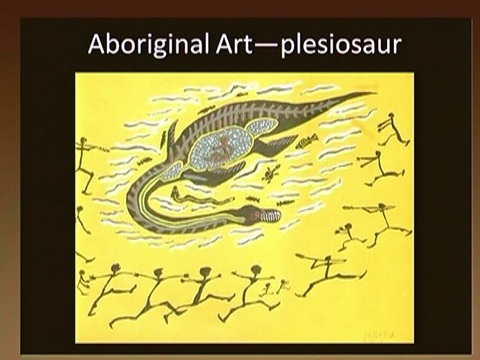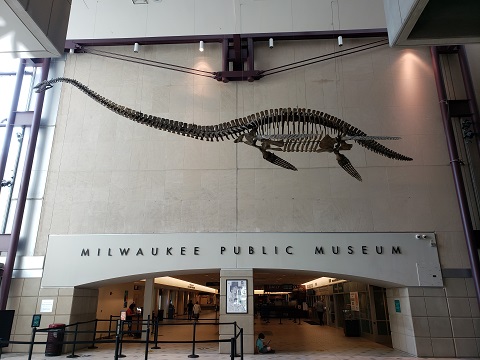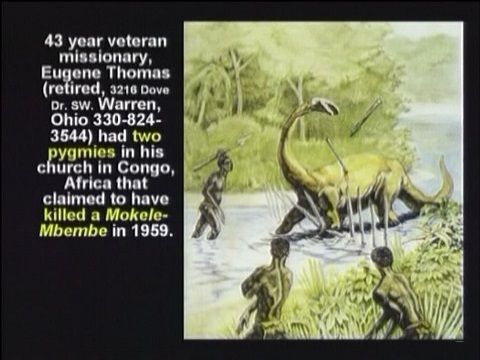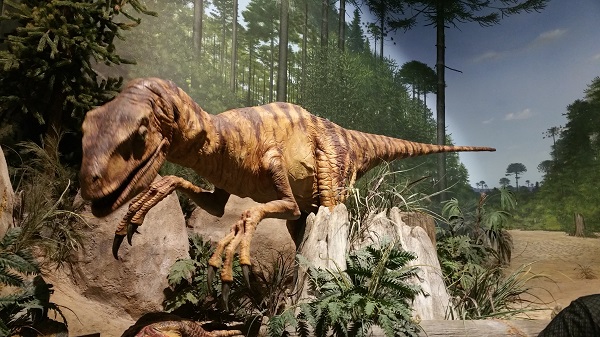
The title is of course a play on the line from Shakespeare’s play Romeo and Juliet, where Juliet laments the fact that her new found love Romeo is from the family of Montague. The two families, the Montagues and Juliet’s family, the Capulets, have been feuding for some time, which sometimes erupted into dueling. The animosity between the two families sets the background for the play. Juliet expresses her dismay with the famous discourse that begins with “O Romeo, Romeo, wherefore art thou Romeo?” and includes the lines:
‘Tis but thy name that is my enemy;
Thou art thyself, though not a Montague.
What’s Montague? It is nor hand, nor foot,
Nor arm, nor face, nor any other part
Belonging to a man. O, be some other name!
What’s in a name? That which we call a rose
By any other name would smell as sweet;
Juliet’s well put and clear meaning being that Romeo would still be Romeo if he were called by any other name. Which is where we pick it up concerning dinosaurs.
Dinosaurs by Any Other Name are Still Dinosaurs
I originally wanted to call this article “Dragons are Dinosaurs.” But dinosaurs are also called by other names and perhaps just as importantly the term “Dinosaur” is limited to land-dwelling creatures, but I want to cover flying and swimming creatures as well. So let me clarify right here, right now, that I know that technically, dinosaurs are land-dwelling creatures created on day six of the creation week (Gen 1.24-25). But for the purpose of this article, due to the steady pounding of “dinosaurs lived millions of years ago” by evolutionists, and the fact that all manner of creatures considered dinosaurs (land, air and sea creatures) appeared in the “Jurassic Park” movies, I’m convinced most people think of both flying creatures, such as pterosaurs, and swimming creatures, such as plesiosaurs, as “dinosaurs” who lived (at least in popular thought) in the age of the land-dwelling dinosaurs. So I will group them all together as “dinosaurs” for the purpose of this article.
Speaking of “the age of dinosaurs,” most people believe that was millions and millions of years ago. The asteroid that struck the edge of the Yucatan peninsula in Mexico, which caused effects that supposedly wiped out the dinosaurs, hit earth supposedly 65-66 million years ago. So the dinosaurs lived, it is thought, before that: from about 250 to 65 million years ago. But it’s that incorrect “age of the dinosaurs” this article seeks to dispel.
Prevailing evolutionary (and thus secular) thought holds that early man didn’t appear until 2-3 million years ago, with our particular species – homo sapiens – appearing only 200,000 years ago. If that’s true then it would be impossible for humans – homo sapiens – to ever have seen living dinosaurs. The problem with that is, as I point out in my previous article “Why have so many humans seen dinosaurs“, (I was tempted to make this article part 2 of that article), there are literally hundreds of accounts of humans seeing dinosaurs and these accounts come from all over the world. The accounts describe creatures with features strikingly similar to those of dinosaurs.
The fact that they come from all over the world, from all different time periods, from people of all cultures and languages, points to the fact that not all of these people can be mistaken or hallucinating. Nor are they all making up the same stories with the same creatures with the same features as the villain. No, what this points to is a common human experience: that people from all lands and all cultures, in both the distant past and the very recent past, have encountered living dinosaurs. This is easy to explain in the Biblical framework where dinosaurs were created on the same day as man (Gen 1.24-29) and would have survived the global flood of Noah’s day by being on the ark like every other land creature. But it is inexplicable in the secular framework where dinosaurs have been extinct for 65 million years.
We’ll look at just a few of the hundreds of dinosaur sightings (including flying and swimming creatures) and look at the names that were given to them. When you understand that ancient humans were not digging up and reconstructing disarticulated (bones not joined together – typically scattered over an area) dinosaur bones and reconstructing them, then you understand the only way to account for all these dinosaur sightings is by the obvious explanations. People have reported seeing what we describe as “dinosaurs” because people have actually seen living dinosaurs. This is further evidence that the millions of years, secular, evolutionary worldview is wrong. So let’s get to it. Let’s look at just a few of the dinosaur accounts given by people who live in the recent past.
Dinosaur Names and Sightings Up First:
Dragons Are Dinosaurs
“Dragon” is the most popular name for dinosaurs before 1841. What happened in 1841? Sir Richard Owen, a famous British anatomist and the first superintendent of the British Museum, who was a contemporary of Darwin, but a staunch anti-Darwinist, “on viewing the bones of Iguanodon and Megalosaurus, realized these represented a unique group of reptiles that had not yet been classified. He coined the term “dinosaur” from Greek words meaning ‘terrible lizards.'”[1]
So you won’t find the word “dinosaur” in the Bible for two reasons:
1) The most popular version of the Bible for many years, the King James or Authorized version, was completed in 1611, hundreds of years before the word “dinosaur” was invented. What word is used in that version for dinosaurs? Most often it is the word “dragon.”
2) The translators of the NIV and the ESV, who should know better, succumbed to the anti-biblical thoughts that dinosaurs died out millions of years ago and the corollary: there’s no such thing as a dragon. So instead of translating the most common word for dragon, תננין Tanniym as the King James does – “dragon” – they went with a creature that is neither like a dinosaur nor a dragon – often translating the word as “jackal.”
There are at least four words used to describe dinosaurs, (five if you count one that’s disputable), but the word the KJV translates “dragon” occurs most often. To see how it’s used in the Bible, I’ll give you a freebie that I prepared for people taking my museum tours: Go to the Tour Extras page and type in the keyword “dinowords” (with no quotes) and you’ll get a list of the Hebrew words used to refer to dinosaurs and the verses they occur in. For this article I’d like to focus on some of the non-biblical accounts we see of people using various words like dragon to describe dinosaurs.
The Bures (England) Dragon
CMI’s Dr. David Catchpoole relates an account from a Chronicle from 1405 in England:
“Close to the town of Bures, near Sudbury, there was lately appeared, to the great hurt of the countryside, a dragon, vast in body, with a crested head, teeth like a saw, and a tail extending to an enormous length. Having slaughtered the shepherd of a flock, it devoured many sheep.”[2] Dr. Catchpoole suggests that a creature with features “as ‘crested-head’ and ‘tail extending to an enormous length’, are consistent with this ‘dragon’ being a dinosaur-like creature.”
In the booklet they show a picture of dilophosaurus as a possibility. Some of you may remember that miniaturized version of dilophosaurus appeared in Jurassic Park. They didn’t want this therapod to compete in size with the main star, T-Rex, so they shrunk it a bit. They also gave it unsubstantiated features like a retractable frill and the ability to spit some type of blinding fluid or poison. I show it below just for reference of what it (if depicted full size) might have looked like. Notice the double crest on the head (the “di” in the name-means two.)
Another possibility: monolophosaurus, similar to dilophosaurus but with a single crest on its head. Here is the display of monolophosaurus from the Milwaukee Public Museum:
The Emperor’s Dragons

Marco Polo recorded the emperor of China raised dragons (dinosaurs).
In the 13th century, explorer Marco Polo, who spent a number of years in China reported that the emperor raised dragons to pull his chariots. This necessitated the position of a “Royal Dragon Feeder” to care for the exotic creatures.
Dragons Intimidated the soldiers of Alexander the Great
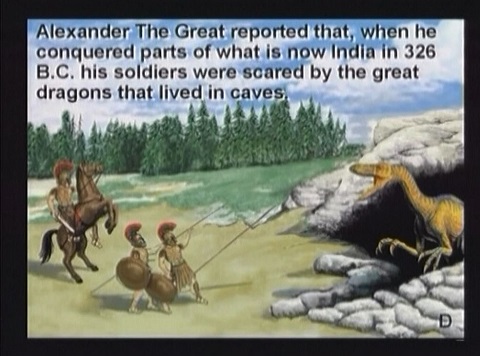
Soldiers of Alexander the Great encountered a fierce dragon (dinosaur).
“After Alexander the Great invaded India he brought back reports of seeing a great hissing dragon living in a cave. Later Greek rulers supposedly brought dragons alive from Ethiopia” [3]
Dinosaurs are also called Monsters
Perhaps the most famous of these monsters is the Loch Ness Monster. There are literally hundreds of sightings. Those who got a good view of it consistently say the monster looks like a plesiosaur. A highly respected British naturalist and painter, Sir Peter Scott, one of Britain’s most respected naturalists, who was also a painter, claims to have seen it and created this depiction of it. [4]
Plesiosaurs have not only been seen in Loch Ness. There’s an interesting aboriginal drawing of a plesiosaur that has eaten one of the people:
What I find fascinating about this picture is: 1. The proportions. The proportions are correct. Below is a plesiosaur on display at the Milwaukee Public Museum. Notice at the bottom of the picture is a person sitting. That person is in correct proportion to the person in the stomach of the creature in the aboriginal drawing. 2. The teeth. Notice the many sharp interlocking teeth in the drawing. Below is a close up on the teeth on the plesiosaur in the museum. Notice the aboriginal art has correctly depicted the many sharp interlocking teeth. It looks to me like the aboriginal people saw a live plesiosaur. Of course then at the bottom we have reports of plesiosaurs eating sheep. If they can catch and eat a sheep, they can probably catch and eat a human!
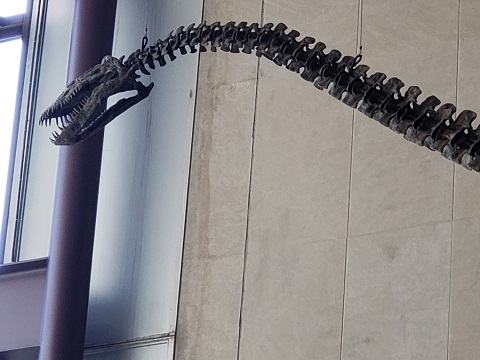
Note the accurate depiction the aboriginal art made of the many sharp interlocking teeth of a plesiosaur.
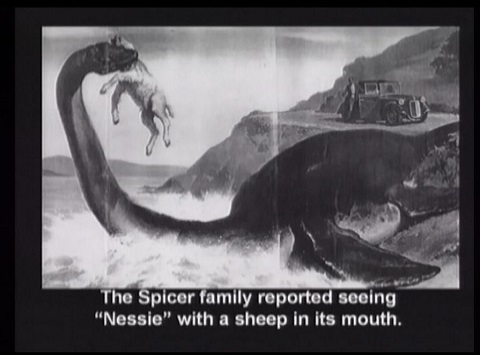
If a plesiosaur can catch and eat a sheep, it can probably catch and eat a human!
Pterosaurs are “Winged Serpents”
The Greek Historian Herodotus wrote:
“There is a place in Arabia, situated very near the city of Buto, to which I went, on hearing of some winged serpents; and when I arrived there, I saw bones and spines of serpents, in such quantities as it would be impossible to describe. The form of the serpent is like that of the water-snake; but he has wings without feathers, and as like as possible to the wings of a bat.” [5]
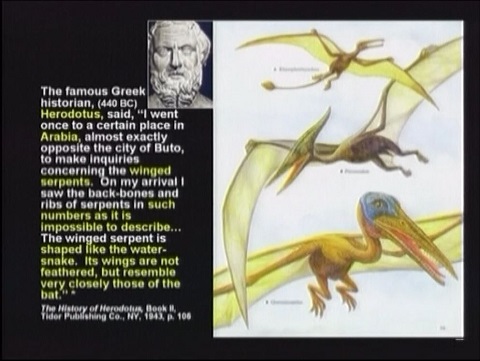
Herodotus recorded “winged serpents”
The Jewish Historian Josephus wrote of Flying Reptiles:
Josephus told of small flying reptiles in ancient Egypt and Arabia and described how Moses used their natural predators, the ibis (which he records as ibes), to drive off the “serpentine kind”, which cleared the ground before him and allowed him to surprise the Ethiopians. [6]
Pterosaurs are the original Thunderbird
Native America Indians reported how thunderstorms brought thunderbirds. Here is an example where they confused cause and effect. The birds didn’t bring the storms, the storms brought the large pteranodons as author and researcher Daryl Isaacs explains as he relates the account.[7]
Bunyips are Hadrosaurs (a type of duck-billed dinosaur)
Dr. David Catchpoole [8] relates another account of aboriginal people encountering a dinosaur. They call it a “bunyip.” When they draw a picture of it, it looks amazingly like a duck-billed dinosaur known as a hadrosaur. Below is a hadrosaur at the Chicago Field Museum.
_800.jpg)
A Bunyip – below A Hadrosaur dinosaur at the Chicago Field Museum
Above – a “Bunyip” as desribed by aboriginal people, inset a more modern depiction
which looks like a Hardrosaur[[9] (below)
_20210517_800.jpg)
Above: A Duck-billed dinosaur known as a “Hadrosaur” at the Chicago Field Museum
Mokele-Mbembe – A Sauropod Dinosaur in the swamps of Congo
The name Mokele-Mbembe means: “One that stops the flow of rivers.” From descriptions, it’s a sauropod dinosaur (apatosaurus?). In addition to the missionary in the Congo who met natives who have both seen and killed the creature, there are reports of many in Cameroon who have seen the creature. I did a fuller treatment in the previous article here.
Conclusion
The accounts go on and on. Dragons. Monsters. Winged serpents, thunderbirds, flying reptiles, bunyips, Mokele-Mbembe, Grendel (the monster Beowulf fought – a therapod dinosaur). Name after name. Witness after witness. Account after account from all around the world in all periods of time, including modern times. The accounts are from historians, scientists, explorers and lots and lots of testimonies from everyday people like you and me from around the globe. All describing creatures we would call dinosaurs (including the creatures that swim and fly.) These are not fairy tales, and these people are not mistaken and they’re not all fabricating. (Though admittedly with popular phenomena like Nessy, some reports are likely fabrications. There will always be attention seekers.)
The depictions are too accurate. The environments (thunderstorms, caves, rivers in the deep jungle) are all too likely. What does science do? All sciences and all scientists attempt to do the same thing: make an inference to the best explanation to explain all the data, not just the cherry-picked data that supports your theory. When you look at all the data, including items I did not include here (like dinosaur fossil bones which have intact soft-tissue and blood cells, indicating they are clearly young), the best inference is clear: Dinosaurs lived recently and, in fact, some dinosaurs may still be alive today.
The evidence does not point to creatures that went extinct 65 million years ago. The evidence points to the Biblical picture: Dinosaurs were created on day six with man, boarded the ark with the other creatures and have faired like other creatures after the flood with some going extinct due to change in the environment and habitat after the flood, decreasing habitat as human populations grew (which still happens to creatures today) and the hunting and predation by humans to make it safe for people to live (which still happens today). St. George and all those other heroes did slay the dragon to make it safe for the townspeople. Who wants to live next door to a monster that might eat you?
Call them what you will, a dinosaur by any other name is still, recognizably, a dinosaur.
Duane Caldwell | October 29, 2021 | Printer friendly version
Follow @rational_faith_
Notes
1. Ken Ham, essay “What really Happened to the Dinosaurs, in The New Answers Book, Green Forest, AR: MasterBooks, 2006, p.158
Back
2. David Catchpoole, What About Dinosaurs, CMI Booklet, 2008, p. 8, who references:
Cooper, B., After the Flood – The early post-Flood history of Europe traced back to Noah, Wes Sussex, UK: New Wine Press, 1980, pp.130-161
Back
3. “Dragons In History”, Genesis Park, Accessed 10/27/21, https://www.genesispark.com/exhibits/evidence/historical/dragons/
Back
4. See The Legend of Loch Ness, http://www.pbs.org/wgbh/nova/ancient/legend-loch-ness.html, accessed 7/14/2016
Back
5. ref from “Dragons In History”, Genesis Park, Accessed 10/27/21, https://www.genesispark.com/exhibits/evidence/historical/dragons/
Back
6. Flavious Josephus, Antiquities of the Jews, 2.10.2
ref from the William Whiston Translation The Works of Josephus: New Updated Edition, Peabody, MA: Hendrickson Publishers, 1987, p. 69
Back
7. Darek Isaacs ref. from. Dragons or Dinosaurs? – Creation or Evolution? CMI DVD 2010
Back
8. David Catchpoole ref. from Dragons or Dinosaurs? – Creation or Evolution? CMI DVD 2010
Back
9. Ref. From Dinosaurs And Dragons The Truth Behind the Legends, CMI color pamphlet, p. 14
Back
Images
Featured: Therapod dinosaur as depicted at AIG’s Creation Museum Kentucky, Duane Caldwell
Monolophosaurs at the Milwaukee Public Museum, Duane Caldwell
Marco Polo and Dinos, The Creation Series
Alexander the Great and Dinos, The Creation Series
Aboriginal Art – Plesiosaur – A Brief, but True, History Of Time, CMI
Plesiosaur (fossil) at the Milwaukee Public Museum, Duane Caldwell
Plesiosaur (fossil Close up) at the Milwaukee Public Museum, Duane Caldwell
Plesiosaur – with sheep, The Creation Series
Herodotus and Pterosaurs, The Creation Series
Hadrosaur (fossil) at the Chicago Field Museum, Duane Caldwell
Mokele-Mbembe, The Creation Series

_480.jpg)
